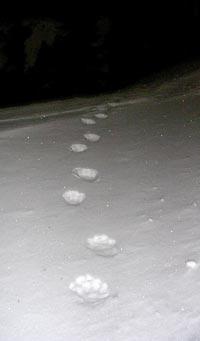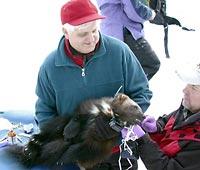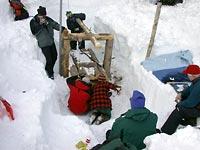State researchers to track elusive wolverine's secrets

She was small, about 19 pounds, and surprisingly docile for a creature that, according to legend, could rip out the throat of a bull elk.
But researchers hope a young animal they captured earlier this month will help unravel some of the mystery — and myth — surrounding one of North America's least-understood wild creatures.
For the first time in the Northwest, government researchers were able to capture a reclusive wolverine in the North Cascades and put a radio collar on her to track her movements.
"For a wildlife biologist, it's a career highlight to work with an animal this rare," said John Rohrer, a biologist with the Okanogan-Wenatchee National Forest.
With thick fur, short legs and powerful jaws, wolverines are actually related to badgers and weasels but can look, from some angles, like tiny bears. They are meat eaters that travel alone, in mountainous terrain, often moving 40 miles in a day scavenging and preying on marmots and squirrels.
Sometimes compared to Australia's ill-tempered Tasmanian devil, wolverines have a reputation for being ferocious, using their vicious teeth and ivory-hued claws to protect their food. But they reside in such inaccessible terrain that almost nothing is truly known about them.
"We don't know how they live, where they go, how many of them there are," said Keith Aubry, a biologist with the Forest Service's Pacific Northwest Research Station in Olympia.
"There are stories from the 1600s and 1700s about them being so vicious and terrifying they'd jump on the backs of elk and kill them," he said. "But they're not like that at all."
Secretive and shy, wolverines generally keep to themselves, although they've been known in Alaska to break into cabins and soil everything in sight.
Once common in the Sierra Nevada range, they haven't been seen there since 1925, and were probably wiped out by poison, trapping and gunshots in California.
Environmental groups recently petitioned the government to list the wolverines for protection under the Endangered Species Act, but the U.S. Fish and Wildlife Service declined, arguing too little was known to suggest the animals were at risk in the Lower 48. They are still legally trapped in Montana and Alaska.
"In the 1970s and 1980s, many biologists thought wolverines were gone from Washington," Aubry said. "It's only in the last 10 years we were sure they were here."
And it wasn't until Feb. 11 that scientists in Washington saw one up close.
Buoyed by information from biologists in recent years who've spied tracks, photographed wolverines with remote cameras and even caught one on videotape racing across a mountain slope on a sunny day, Aubry decided to try to capture and tag some of these elusive creatures. They've never been studied in the Northwest.
Using a trap built like a little log cabin and baited with parts of deer and beaver carcasses, researchers caught a 1-year-old female about 20 miles from the Canadian border just outside the boundary of the Pasayten Wilderness Area.
Biologists named her Melanie because researcher Jeff Copeland had to skip his granddaughter Melanie's birthday party to race by snowmobile to retrieve the wolverine, nearly 3 feet long with a 7-inch tail.
Because Melanie was a juvenile, her discovery gives researchers hope they might be able to trap others in her family nearby.
After immobilizing her with drugs, researchers attached a collar, checked her health and released her so they could follow her movements over the next 18 months.
That, researchers said, could help them understand what wolverines need to survive.
"We want to know if this is a resident animal or is coming down from Canada," Rohrer said. "What they've found in British Columbia and Idaho is that they are very sensitive to disturbance at their den sites, so we'd like to know where those are."
But researchers also want to study the animals "because they're mysterious; because they're symbolic of wilderness and wild things," Aubry said.
"And the best way to ensure wolverines continue in Washington is to learn as much about this population as we can."
Craig Welch: 206-464-2093 or cwelch@seattletimes.com

